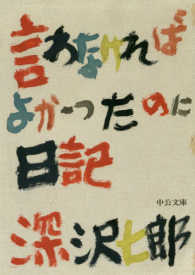- ホーム
- > 洋書
- > 英文書
- > History / World
Full Description
During World War II the Japanese imprisoned more American civilians at Manila's Santo Tomas prison camp than anywhere else, along with British and other nationalities. Placing the camp's story in the wider history of the Pacific war, this book tells how the camp went through a drastic change, from good conditions in the early days to impending mass starvation, before its dramatic rescue by U.S. Army "flying columns." Interned as a small boy with his mother and older sister, the author shows the many ways in which the camp's internees handled imprisonment--and their liberation afterwards.
Using a wealth of Santo Tomas memoirs and diaries, plus interviews with other ex-internees and veteran army liberators, he reveals how children reinvented their own society, while adults coped with crowded dormitories, evaded sex restrictions, smuggled in food, and through a strong internee government, dealt with their Japanese overlords. The text explores the attitudes and behavior of Japanese officials, ranging from sadistic cruelty to humane cooperation, and asks philosophical questions about atrocity and moral responsibility.
Contents
Table of Contents
Acknowledgments ix
Introduction: Telling the Santo Tomás Story 1
1. War Clouds Over Eden 9
2. Internment 24
3. A Porous Prison 35
4. Dorms, Shanties, and Sex 49
5. "Cheer Up! Everything's Going to Be Lousy" 68
6. Child's Play 82
7. Power: The Japanese 94
8. Power: The Internees 104
9. Hunger 116
10. Threat vs. Hope 132
11. "They're Here!" 143
12. Aftermath 157
13. Significance 178
Appendix I: Chronology 193
Appendix II: The Camp's "Ten Commandments" 198
Appendix III: The Literature of Santo Tomás 200
Notes 203
Bibliography 221
Index 229
-

- 電子書籍
- 紺碧の海







